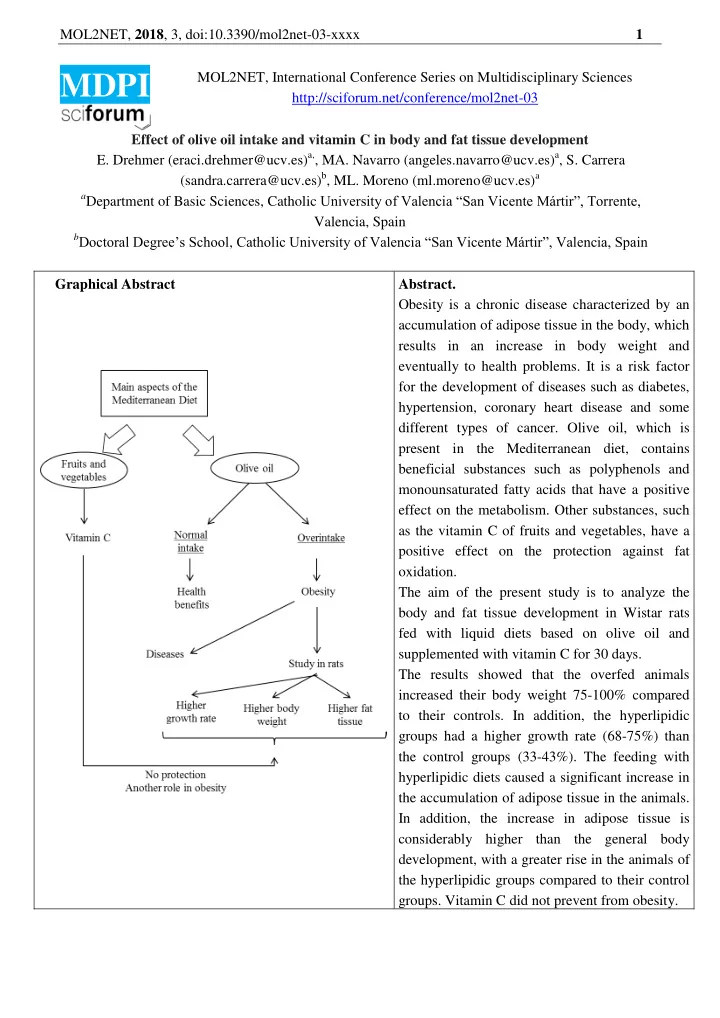

MOL2NET, 2018 , 3, doi:10.3390/mol2net-03-xxxx 1 MOL2NET, International Conference Series on Multidisciplinary Sciences MDPI http://sciforum.net/conference/mol2net-03 Effect of olive oil intake and vitamin C in body and fat tissue development E. Drehmer (eraci.drehmer@ucv.es) a, , MA. Navarro (angeles.navarro@ucv.es) a , S. Carrera (sandra.carrera@ucv.es) b , ML. Moreno (ml.moreno@ucv.es) a a Department of Basic Sciences, Catholic University of Valencia “San Vicente Mártir”, Torrente, Valencia, Spain b Doctoral Degree’s School , Catholic University of Valencia “San Vicente Mártir”, Valencia, Spain Graphical Abstract Abstract. Obesity is a chronic disease characterized by an accumulation of adipose tissue in the body, which results in an increase in body weight and eventually to health problems. It is a risk factor for the development of diseases such as diabetes, hypertension, coronary heart disease and some different types of cancer. Olive oil, which is present in the Mediterranean diet, contains beneficial substances such as polyphenols and monounsaturated fatty acids that have a positive effect on the metabolism. Other substances, such as the vitamin C of fruits and vegetables, have a positive effect on the protection against fat oxidation. The aim of the present study is to analyze the body and fat tissue development in Wistar rats fed with liquid diets based on olive oil and supplemented with vitamin C for 30 days. The results showed that the overfed animals increased their body weight 75-100% compared to their controls. In addition, the hyperlipidic groups had a higher growth rate (68-75%) than the control groups (33-43%). The feeding with hyperlipidic diets caused a significant increase in the accumulation of adipose tissue in the animals. In addition, the increase in adipose tissue is considerably higher than the general body development, with a greater rise in the animals of the hyperlipidic groups compared to their control groups. Vitamin C did not prevent from obesity.
MOL2NET, 2018 , 3, doi:10.3390/mol2net-03-xxxx 2 Introduction Obesity is considered one of the most important health issues in industrialized countries due to its increasing frequency and globalization. It presents epidemic data worldwide. Multiple factors are implicated in their origin, such as social, psychological, metabolic, dietary and molecular ones, among others. Obesity is a chronic disease characterized by an accumulation of adipose tissue in the body, which results in an increase in body weight and eventually to health problems. It is a risk factor for the development of diseases such as diabetes, hypertension, coronary heart disease and some different types of cancer. Olive oil, which is present in the Mediterranean diet, contains beneficial substances such as polyphenols and monounsaturated fatty acids that have a positive effect on the metabolism. Other substances, such as the vitamin C of fruits and vegetables, have a positive effect on the protection against fat oxidation. Materials and Methods Male Wistar rats (150-180 g) housed (one or two animals per cage) under a 12 h light/dark cycle at 22ºC and 60% humidity and maintained on standard chow and water ad libitum, were used. Rats were divided into four groups which received control and hyperlipidic liquid diet during 30 days, getting or not a vitamin C supplement: Group 1: Control Olive Oil Diet (C.O.) Group 2: Hyperlipidic Olive Oil Diet (H.O.) Group 3: Control Olive Oil Diet + Vitamin C (C.O.C) Group 4: Hyperlipidic Olive Oil Diet + Vitamin C (H.O.C) The proportion of fats in the diet was provided by the inclusion of olive oil in the diet. The dietary intake of the animals was recorded daily and the body weight was measured weekly. After the 30 days of treatment, rats were anaesthetized with isoflurane and killed by decapitation and all the samples were taken for the determinations. Results BODY DEVELOPMENT WEIGHT (g) C.O. C.O.C H.O. H.O.C 181 ± 2.9 181 ± 4.3 178 ± 3.1 181 ± 3.7 Day 1 199 ± 3.4 204 ± 4.9 212 ± 4.9 219 ± 3.8 Day 7 Day 14 212 ± 4 220 ± 5.8 242 ± 7.7 253 ± 5.8 230 ± 5 243 ± 8.1 272 ± 10 286 ± 8.5 Day 21 241 ± 4.7 259 ± 9.8 300 ± 13 318 ± 13 Day 30 121.12 ± 2.9 $$ 137 ± 12 $$ * Total increase 60.3 ± 4.6 78.4 ± 9** FAT TISSUE DEVELOPMENT 3.54 ± 0.82 $$ 4.15 ± 0.47 $$ White Fat. Day 30 1.87 ± 0.43 1.71 ± 0.32 0.45 ± 0.08 $ 0.54 ± 0.09 $ * 0.38 ± 0.05 0.43 ± 0.07 Brown Fat. Day 30 Values are expressed as mean ± SEM. The number of rats per group was 7-10. The statistical difference is indicated as follows: *p<0.05, **p<0.005 C.O. vs C.O.C and H.O. vs H.O.C; $ p<0.05, $$ p<0.005 C.O. vs H.O. and C.O.C vs H.O.C.
MOL2NET, 2018 , 3, doi:10.3390/mol2net-03-xxxx 3 Conclusions The overintake of a nutritional and healthy fat such as olive oil did not prevent from the appearance of obesity. Supplementation with vitamin C did not have a protective effect on body and fat development. References Morgen CS, Sørensen TI. Obesity: global trends in the prevalence of overweight and obesity. Nat Rev Endocrinol. 2014; 10(9): 513-514. Doi: 10.1038/nrendo.2014.124. Korner J, Aronne LJ. The emerging science of body weight regulation and its impact on obesity treatment. J Clin Invest. 2003; 111(5): 565 – 570. Doi: 10.1172/JCI200317953 Zhang H, Tsao R. Dietary polyphenols, oxidative stress and antioxidant and anti-inflammatory effects. Cur Opinion in Food Sci 2016; 8: 33-42. Doi: https://doi.org/10.1016/j.cofs.2016.02.002 Presti G, Guarrasi V, Gulotta E, Provenzano F, Provenzano A, Giuliano S, Monfreda M, Mangione MR, Passantino R, San Biagio PL, Costa MA, Giacomazza D. Bioactive compounds from extra virgin olive oils: Correlation between phenolic content and oxidative stress cell protection. Biophys Chem. 2017; 230: 109-116. Doi: 10.1016/j.bpc.2017.09.002. Nogueira CR, Borges F, Lameu E, Franca C, Ramalho A. Effects of supplementation of antioxidant vitamins and lipid peroxidation in critically ill patients. Nutr Hosp. 2013; 28(5): 1666-1672. Doi: 10.3305/nh.2013.28.5.6590.
Recommend
More recommend